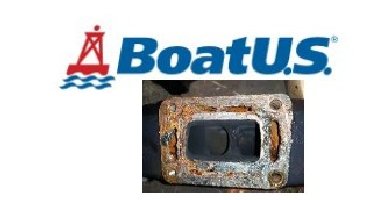Inspecting Exhaust Manifolds And Risers
Product Description
Information was gained from BoatU.S.posting.
Inspecting Exhaust Manifolds And Risers
Keeping a wary eye on raw-water cooled manifolds and risers can prevent the premature death of your engine.
Details:
The owner of a 30' powerboat hops aboard his boat one day to go for a cruise, but his inboard V-8 engine is slow to start. When it finally does start, he notices a distinct knocking noise which he's never heard before. He continues to run the engine briefly, and then shuts it down to investigate the cause. Eventually he removes the spark plugs and discovers water in the # 2 and #4 cylinders (hmm ...). Later, when the engine is torn down for inspection, it is discovered that the #4 piston connecting rod is bent and the cylinder walls are rusted due to water intrusion. How did water get into the cylinders? (Hint: It's not supposed to be there.)
There are several possibilities, but if you guessed "Act of God," try again. More likely, saltwater passed into the cylinders through a leak in either the raw-water cooled exhaust "manifold" or the "riser." Once water gets inside the cylinders, the result is usually catastrophic engine failure. It can ruin your day, and much of your summer by the time busy mechanics get around to a total engine rebuild (if possible) or replacement. Because the engine is often the single most expensive part of your boat, it makes sense to inspect or clogged. In which case, you may also notice less water exiting the exhaust discharge if each side has an independent exhaust hose (unlike most I/O's). Note that the engine temperature gauge may not indicate overheating when idling at low speed. However, all things being fairly equal on V-block engines, if one side becomes clogged the other is usually not far behind, so the touch test is not very conclusive. A more scientific approach is to hire an engine surveyor who has an infrared pyrometer. This instrument can determine temperature variation in cast-iron exhaust parts much better than your hand, plus you profit from the surveyor's experience.
To learn more right click the link below.and "Open"
https://www.boatus.com/seaworthy/swbtob.asp
more information about this product





 Click Image to Enlarge
Click Image to Enlarge
View Video Galleries
Helpful information for the boaters; tips and entertainment collection.
View Photo Galleries
A collection of photo galleries related to
ski-racing, fishing and water sports.
Share with